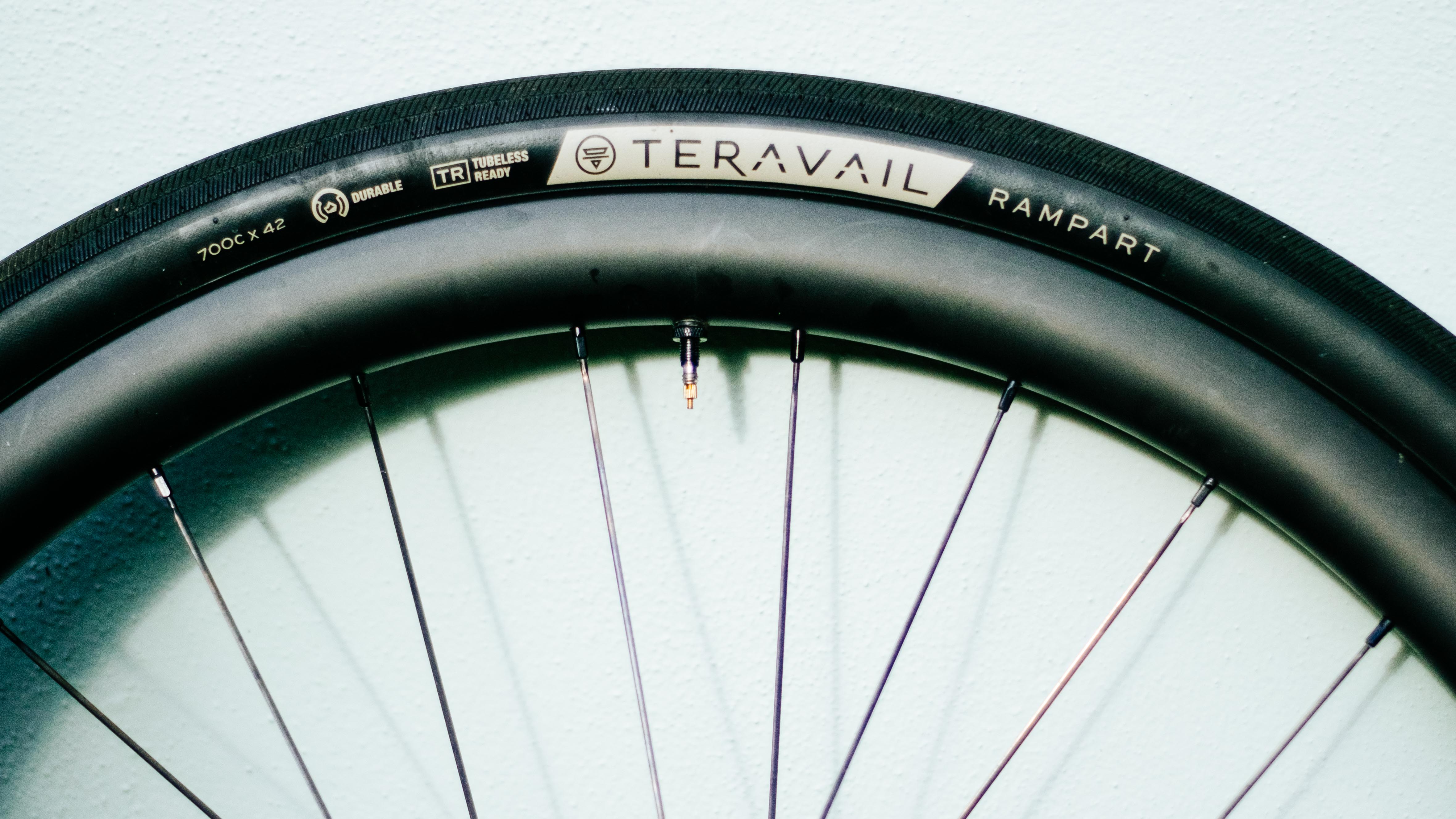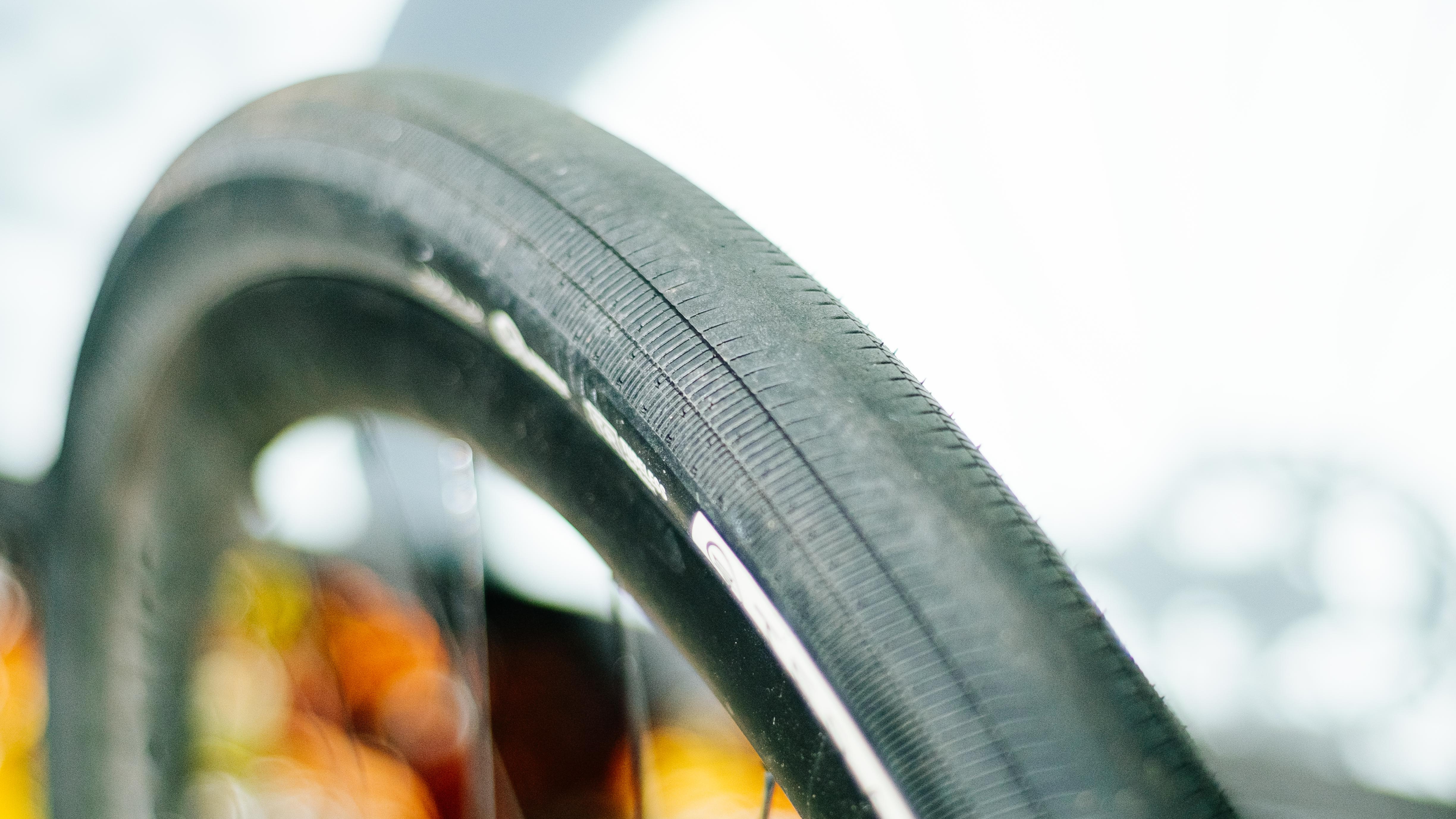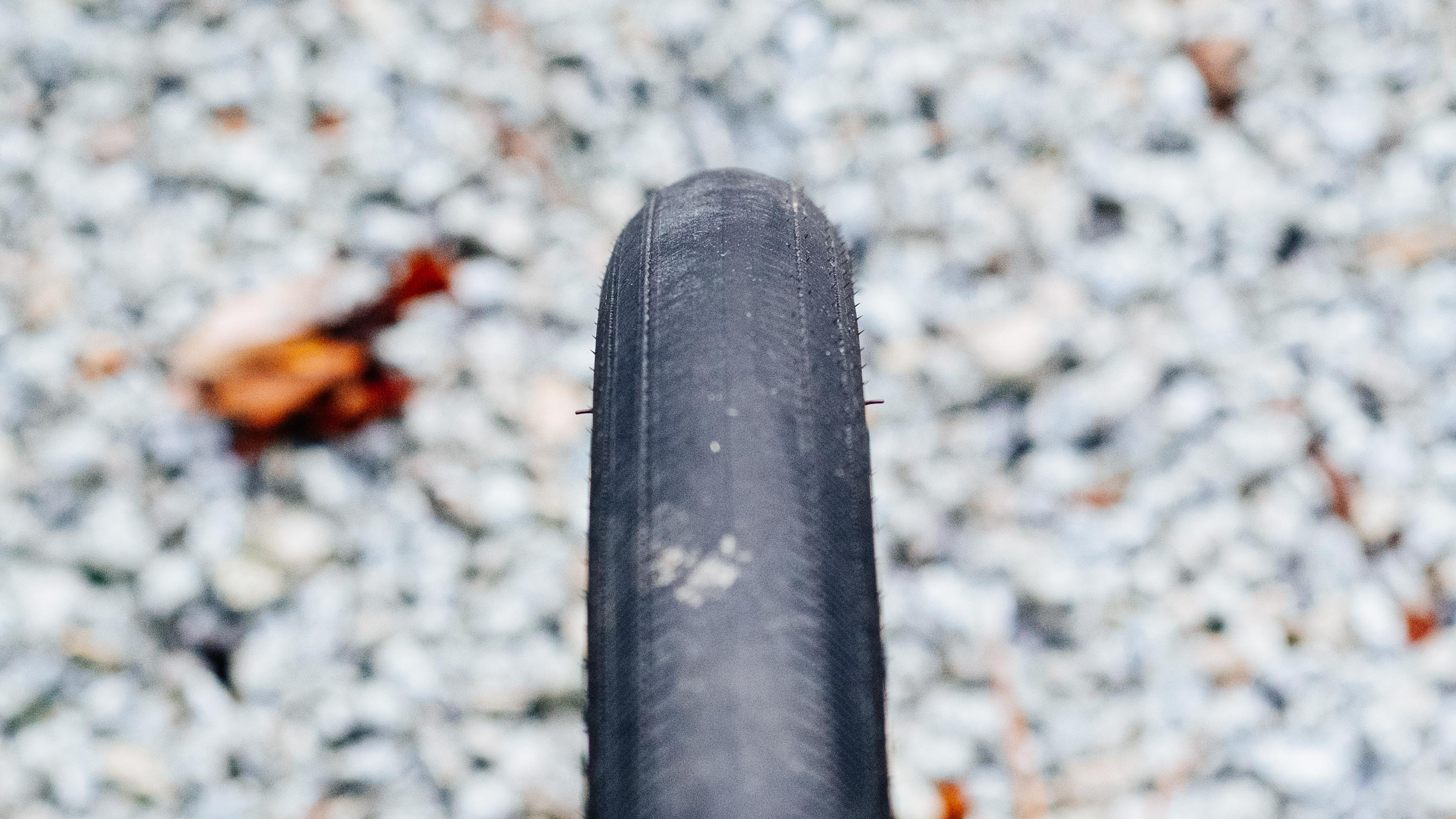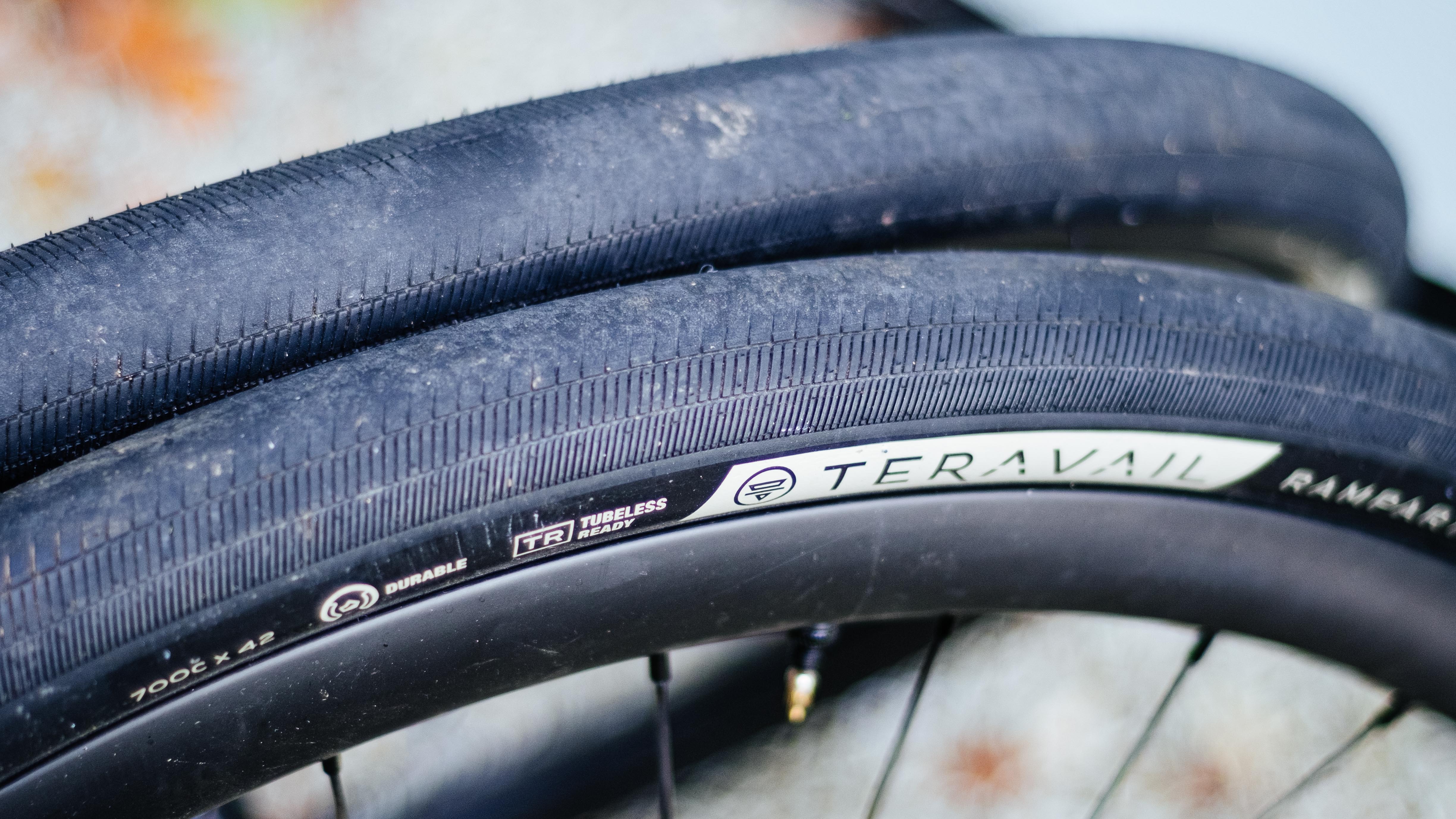Cyclingnews Verdict
A perfect option for light touring and winter road riding
Pros
- +
Confidence-inspiring grip even with a loaded bike
- +
Straight-line speed is excellent
- +
Thicker tread great for longevity
Cons
- -
Heavier than road options in narrow widths
You can trust Cyclingnews
Every review I pen of late begins with a disclaimer that ‘Gravel’ means many different things to many different people. Mostly for the sake of neatness, tyres that are deemed ‘all-road’ slip into our guide to the best gravel tyres, but the term ‘all-road’ is perhaps even more nebulous than ‘gravel’. All-road implies all roads, so that can be literally everything from perfect tarmac to a bumpy, gravelly, muddy forest service road.
The Teravail Rampart is an all-road tyre, but it’s definitely designed for actual roads. It’s a wonderful, big slick that can handle broken tarmac and light gravel in the dry, but beyond that, you’ll want something more specialized. For endurance riding, fast touring, or just making your gravel bike supremely good fun on tarmac these are a pretty fantastic option, as we’ll get into. They also make a brilliant set to challenge the best winter road bike tyres.

Design and aesthetics
The more knobbly the tyre, the easier this section is to write. The Teravail Ramparts don’t feature lugs, just a lovely wide, totally slick centreline and shoulders descending into three tiers of striations that run nearly perpendicular to the direction of movement of the tyre. It’s a simple recipe, visually speaking, and from a distance, they look completely slick.
While the tread pattern is consistent throughout the range you do get a choice of black or tan sidewalls in both light and supple, and durable options, as well as four widths in 700c up to 42mm, and a single 650b width (47mm). I was furnished with a 42mm, black, durably cased setup. Normally I’d opt for light and fast for general riding, but for these, I went with durable as I wanted to test them out as a light touring tyre, and I prefer stiffer sidewalls when the bike is loaded down; we’ll get into that shortly though.
There isn’t a great deal more in terms of visuals, though I’d like to make it known that at the time of writing the Teravail sidewall branding is my current favourite. Big, but not too big, no bright colours to clash with your paint, not too many stats, and the logo is the right way up with the valve at the top.
Underneath the visuals though the interesting thing from a construction point of view, beyond the usual puncture protection strips and the like, is that the tread rubber itself in the centre is around 1mm thicker than that of the best road bike tyres. This should serve to increase the tyre lifespan as well as provide greater puncture protection.

Performance
I’ll start off with what these tyres aren’t good at: Wet gravel riding. Mud, slop, thick mulch. You could probably tell that though just by looking at them, right? These are often sold alongside gravel tyres, but even though you’ll probably be fitting them to your best gravel bike, think of them as a way to transform it into an endurance road bike or light tourer instead, because if you give these tyres a hard surface to work with they are brilliant.
I initially gave them a runout on an overnight trip around the Lake District on my Fairlight. The route was entirely paved, so there was no point running something with even a bit of gravel bite like the Challenge Getaway, fast though they were on the tarmac. Setup was a breeze, they sealed on the Parcours Alta wheels happily without any sealant in, and with a load of Squirt sealant, I never had any issues.
On the road, the moderately heavy load (I’m a chronic over-packer) gave me a couple of hundred kilometres to test what I think is the ideal use case for the Ramparts: A light touring tyre. In years gone by I’ve had to run something like a Schwalbe Marathon on a cross bike when I wanted some on-road touring utility, but as these are designed for round-the-world loads they absolutely killed the ride and weighed a tonne.
The Ramparts aren’t a cotton-cased race tyre, and in the durable casing they do take a little longer to spin up than a lighter option would, but the way they ride when laden is exceptional. With the extra weight of a bikepacking load, you’d do well to opt for the durable sidewall option too in my opinion. A stiffer sidewall will resist folding under cornering more readily than a more supple one will, meaning that you can get away with lower, more comfortable pressures without things feeling squirmy.
The straight-line speed is brilliant, thanks in part to a lovely round profile. For why roundness is important, our recent look at the WTB Byway, which had a much flatter profile, should be enlightening too. In short, specifically for wider tyres, you end up with a smaller contact patch and can therefore go faster for the same effort.
On rutted, broken tarmac, a slightly sketchy apex, the odd section of cobbles, and on light gravel (in the dry) these tyres were brilliant even with a full load. They inspire confidence in the corners with progressive grip as you lean over, and when you’re cooking your brakes on long descents the rubber compound is tacky enough to avoid lockups. The best thing I could probably say about them is that they didn’t give me much to think about while touring. I was never worried about grip, and the increased tread thickness and more durable casing meant I didn't ever worry about getting a flat. I could just enjoy the view or worry about where the next refuel was.
As is the nature of this job I didn’t get a chance to run these down to the canvas, but my friend Taylor who regularly decides to do insane ultra-distance races uses these as her tyre of choice, which backs up my theory that they hit the sweet spot of durability, handling, and weight.
With the bags off I still love riding these tyres. If you have a gravel bike and, in the winter months find yourself not wanting to go play in the mud, but are also reluctant to take the road bike out on sloppy, slippery, leaf-strewn roads then slap a set of these on and just call your gravel bike a winter road bike. It won’t be as fast, but I’ll bet it’ll improve your confidence in the corners no end. In simple terms they’ll make you feel like you’re riding a motorbike, sticking that knee out as you try and hit the apex perfectly.

Value
Teravail tyres generally sit at the slightly more premium end of the market. They’re not quite Rene Herse territory, but there’s a price uplift over brands like WTB. That being said I am yet to find a better big slick option, so I reckon these do represent pretty decent value. If you also take into account the increased tread thickness over a standard road tyre you’re looking at something that’ll last you a good couple of hard winters riding if you use them for that, or something that’ll get you through multiple tours, perhaps saving you money in the long run.
Verdict
In the right context, I think these might be the best option on the market. For tarmac-based bikepacking, or as a road tyre for gravel bikes, they are exceptional. Even as an option for the best endurance road bikes, which now usually have pretty substantial clearance, they’re a great option.
In the 28mm width I doubt they’d compete with a dedicated road tyre for pure performance, though they still represent a great winter option, in 32mm or above the tables probably turn in favour of the ramparts, especially if distance rather than out and out speed is your goal.
| Attributes | Notes | Rating |
|---|---|---|
| Design and aesthetics | Good looking, simple design. Extra thickness is a bonus | 9/10 |
| Performance | In the right context these are a pretty flawless option, just a little heavier than some | 9/10 |
| Puncture resistance | Extra rubber and a durable casing add up to a pretty resistant package | 9/10 |
| Value | More premium than many, but I think it's worth it | 9/10 |
| Overall rating | Row 4 - Cell 1 | 90% |

Will joined the Cyclingnews team as a reviews writer in 2022, having previously written for Cyclist, BikeRadar and Advntr. He’s tried his hand at most cycling disciplines, from the standard mix of road, gravel, and mountain bike, to the more unusual like bike polo and tracklocross. He’s made his own bike frames, covered tech news from the biggest races on the planet, and published countless premium galleries thanks to his excellent photographic eye. Also, given he doesn’t ever ride indoors he’s become a real expert on foul-weather riding gear. His collection of bikes is a real smorgasbord, with everything from vintage-style steel tourers through to superlight flat bar hill climb machines.
